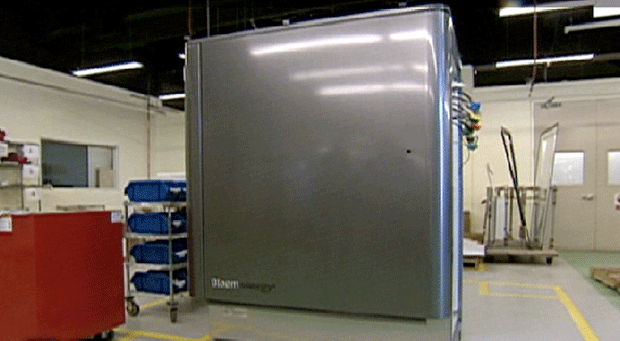Bloom Energy Promises Cheap, Emissions-Free Power From a Small Box
Google, eBay, FedEx have already started using Bloom Boxes

A boxy power plant that could one day produce efficient, inexpensive, clean energy in every home might sound like a pipe dream, but it’s the very real product of a Silicon Valley startup called Bloom Energy. Twenty large corporations that include Google, FedEx, Walmart and eBay have already purchased and begun testing the Bloom Boxes. 60 Minutes recently got a sneak peek at this possibly game-changing energy device.
The Bloom Box idea came from K.R. Sridhar, a former NASA rocket scientist who once built a similar box device to generate oxygen on Mars for future colonists. Sridhar simply turned the concept on its head by pumping oxygen into the box, along with fuel. The oxygen and fuel combine within a new type of fuel cell to create the chemical reaction that makes electricity.
There’s also no need for power lines coming in from an outside source, and Sridhar envisions the box eventually providing energy wirelessly to homes and businesses. That could do away with traditional power plants and the power grid.
Such transformative power may only come about if the Bloom Box fuel cells can work reliably and efficiently — other fuel cell technologies have proven notoriously finicky. Sridhar makes his fuel cells based on cheap sand-based ceramics, coated with special green and black “inks” that allow for the chemical reaction which makes electricity.
One of the simple disks can power a light bulb, and a stack of 64 disks with cheap metal plates in between them can supposedly power a Starbucks. And unlike fuel cells that require pure hydrogen, the Bloom Box can use fuels ranging from natural gas to bio-gas.
Skeptics may find good reason to remain cautious, at least until Bloom Energy officially unveils the device this Wednesday. Sridhar’s project has required around several hundred million dollars to develop, and represents one of the most expensive clean tech projects.
The current Bloom Box also still remains too pricey for residential homes at $700-800,000 per device. But major U.S. companies have bought and tested them with the help of some California subsidies.
Four boxes have already powered a Google datacenter for a year and half, and used just half as much natural gas as a traditional power plant might require. And eBay’s CEO told 60 Minutes that his company’s five boxes have saved more than $100,000 in electricity costs over nine months. eBay’s boxes run on bio-gas made from landfill trash.
Many challenges still lie ahead. Sridhar had to fix one box at Google that simply stopped working, and also changed the air filter system during another incident. And there’s a major question of whether he can mass-produce the devices and eventually bring them down to a targeted price of less than $3,000 for homeowners. But we’ll sit on our excitement for now and applaud the man for thinking big.
[via CBS]